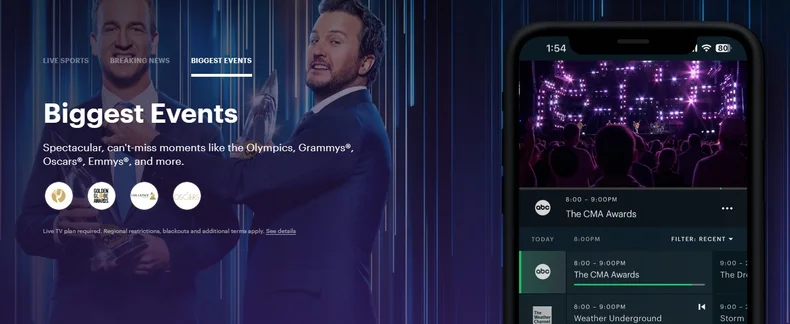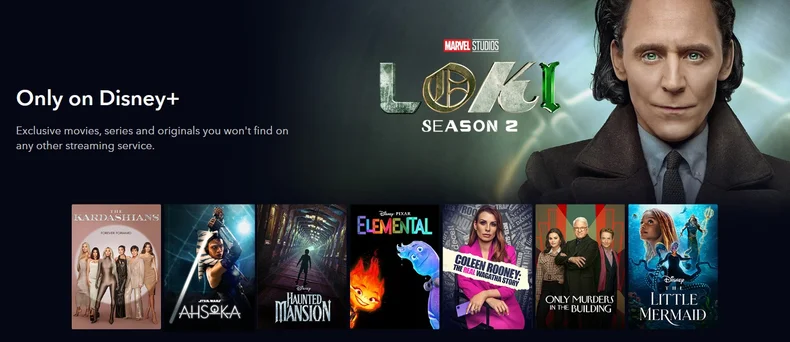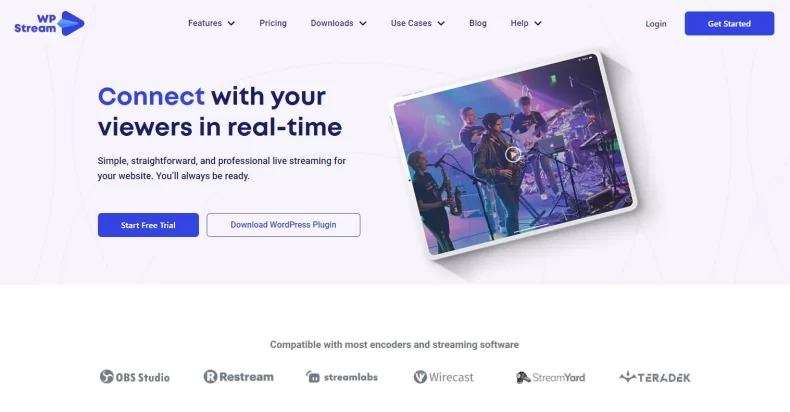Looking to build your own streaming service? In the year 2000, Netflix was an unprofitable startup that provided DVD rentals. The same year, the owners attempted to sell the startup to Blockbuster for $50 million – but they declined. Today, Netflix is worth over $200 billion.
The popularity of Netflix is undeniable, showing the massive revenue potential of streaming platforms. In this article, we’ll show you how to build your own Netflix-like streaming service, step by step. We’ll delve into the intricacies of navigating the streaming industry, offering insights into how to carve out your space in this competitive market.
With tools like WpStream, you’ll be well-equipped to establish a successful streaming service that can rival the industry giants!
Understanding the streaming landscape: Netflix, Hulu, and Disney+
Streaming platforms like Netflix, Hulu, and Disney+ have transformed how audiences consume content. They each have their own successful ways of doing this:
Netflix

With its groundbreaking business model and vast content library, Netflix has revolutionized the entertainment industry. Offering a wide array of shows and movies, this streaming giant played a pivotal role in steering audiences away from traditional media consumption towards on-demand streaming.
Hulu

Distinguishing itself with a blend of on-demand content and live TV, Hulu is definitely unique. Partnering with network TV providers, it provides a diverse range of programming, setting it apart from the Netflix model.
Disney+

Leveraging its extensive collection of beloved franchises, Disney+ has rapidly become a powerhouse in the streaming arena. Its success is rooted in the availability of nostalgic content, appealing to audiences of all ages.
Preliminary steps to start a video streaming service
1. Identify your niche and craft a unique proposition
Choosing the appropriate niche will help you build a committed audience, driving you toward attaining your revenue goals. You should consider factors like emerging market trends, understand your target audience’s interests, and identify gaps in the competition. Thorough research is key at this stage.
To pinpoint your niche, look at your audience’s streaming habits, assess market saturation levels, and study the competition. This analysis will guide you toward potential niches that you can effectively cater to.
Moving beyond niche identification, the next step is to create a unique value proposition that makes you different. This statement communicates why your service is unique and why your target audience should choose your platform over others. It’s important for this proposition to be both concise and clear, showing your niche, services, and uniqueness effectively.
💡Remember: Having a clear focus allows your platform to attract and retain your target demographic easily.
2. Build a solid business plan for your streaming service
A solid business plan acts as a roadmap for your streaming service. It sets your direction, secures investors, assists in the avoidance of costly errors, and guides effective resource allocation.
Your business plan should start with an executive summary. This brief, high-level snapshot of your plan delivers an understanding of your business. It should encapsulate the nature of your streaming service, the target demographics, and substantial components of your plan, like your business’s primary value proposition and revenue generation model.
Next is your company description. This section should go deeper into your business. It should clarify the legal structure of your company, its history, and the variety of streaming services you aim to deliver. Specifically, it should cover:
- Your mission statement that embodies the purpose and values driving your streaming service.
- Your operational strategy that delineates how your streaming service will function and deliver its offerings.
Market analysis comes next. This section needs a dive into your potential competitors and target audience, along with their preferences and behaviors. This is where you demonstrate how your service can fit within or extend what is already on offer – whether it’s by providing unique content, exceptional user experience, or innovative monetization models.
When outlining your organization and management structure, it’s important to note the capabilities and dedication of your team, as they are pivotal to the success of your streaming service.
Moving onto the content type section, you should outline the genre of content your service offers. Will it host movies, series, documentaries, sports, or perhaps a combination of these? This is the point to disclose your content sourcing strategy as well.
In the monetization model section, outline the revenue generation models you plan to incorporate. Your service could follow one or more models like Subscription Video On Demand (SVOD), Transactional Video On Demand (TVOD), Advertising Video on Demand (AVOD), or a hybrid of these.
Lastly, remember to include financial projections in your business plan. Projections should include expected revenue, costs, and profit estimates for at least the next three to five years. Keep your projections cautiously realistic, mindful of not overestimating revenue and underestimating costs.
Your business plan should be iterative in nature. As your streaming service grows and the market changes, regularly review and update it as required. Understand that it’s not carved in stone and be flexible to adapt accordingly. Maintain an upward learning curve where your business plan evolves as the cornerstone of your streaming service.
3. Choose the right content and licensing
A unique portfolio of syndicated, original, or user-generated content can place you ahead of your competition. Maintaining a regular cycle of updates and ensuring the content’s quality remains vital in keeping your audience engaged and returning for more.
Considering the diverse interests of your audience will guide you in sourcing content. For instance, if your unique proposition relies on niche indie movies, licensing from independent filmmakers or supporting user-generated indie content will suit your platform. Alternatively, if your audience prefers mainstream TV shows, getting broadcasting rights from the TV networks will be a more fitting strategy.
After selecting the type of content, you’ll need to underline your strategy for delivering and monetizing it. Popular streaming services rely on four primary monetization models:
- Transactional Video-On-Demand (TVOD): This model works similarly to a traditional video rental store, where users pay per view or download. It generates immediate revenue but may discourage potential customers who prefer flat-rate pricing (ex. Amazon Prime Video Store).
- Subscription Video-On-Demand (SVOD): Users enjoy unlimited access to the entire content library for a regular subscription fee. While SVOD promises stable recurring revenue, convincing users of the subscription’s value can be challenging (e.g., Netflix and Disney+).
- Advertising Video-On-Demand (AVOD): Users watch content for free but must sit through ads. AVOD attracts budget-conscious viewers, though it often takes a substantial viewer base to generate worthwhile advertising revenue (ex. YouTube).
- Hybrid (SVOD + TVOD): Some content is available with a subscription, while premium content requires additional payment. This model can provide the best of both worlds but may risk frustrating customers who believe their subscription should cover all content (ex. Amazon Prime).
Remember to keep in mind copyright laws and content licensing rules. For instance, streaming any content not created by you necessitates the proper lawful permissions. Even if you did create the content yourself, your intellectual property rights must be correctly registered and enforced.
To ensure you are fully compliant with all legalities, consider getting professional legal consultancy. It’s worth noting that laws can differ dramatically across geographical territories, so conduct thorough legal checks within every region you plan to operate. What may be lawful in one country could lead to legal issues in another.
Choosing the best technology for your streaming service
The essential characteristics of your platform – video quality, user experience, scalability, and reliability – will depend entirely on the technology you choose. What really forms the foundation of a streaming service? Well, it isn’t solely about a video player.
The base of a streaming service consists of the carefully interwoven components of streaming software, a hosting platform, the integration of a Content Delivery Network (CDN), a payment gateway, user analytics, security features, and more.
However, if this seems a daunting list, rest assured that there is a solution. With an all-in-one streaming platform like WpStream, established in 2015 with the aim to simplify the process of live streaming, the complexities can be turned into an easy and efficient operation.

WpStream gives you complete control over your website’s content and appearance. This means that you hold the power to steer the user experience in line with your brand ethos. On top of that, it’s designed for extensibility and easy integration with popular streaming software and hardware such as OBS Studio and vMix, allowing you a wide range of extension options.
Thanks to WpStream’s multi-CDN solution, your platform will provide viewers around the globe with a smooth streaming experience. Regardless of where your customers are situated, they can rely on quality and uninterrupted service.
With WpStream’s built-in security features, you can rest easy knowing your content is secure. You have the assurance that your content is not only private but accessed only by your intended audience, maintaining security and integrity.
Setting up a streaming website for both live and on-demand content with WpStream couldn’t be easier. All you need is a WordPress website and the WpStream app to make your dreams of building a Netflix-like streaming service a reality. To learn how to get started, why not check out our complete guide on setting up a streaming website?
Launching and marketing your service: Strategies for success
1. Create a launch plan: First and foremost, you need a well-documented plan that outlines your launch strategy, marketing efforts, and timeline. Acting as your roadmap, this critical document charts the course of your pre-launch journey.
2. Generate pre-launch buzz: Become the ‘in thing’. Use this time to ignite excitement about the imminent unveiling of your platform. You can release teasers or sneak peeks of your features or content on various platforms such as YouTube, Instagram, and your own website.
3. Keep your eyes on the market: Stay ahead of market trends and your competitors’ strategies. Understanding your target audience’s preferences is key to fine-tuning your service.
4. Utilize beta testers and early users: Prior to the official launch, onboard a set of users to test your platform. Their invaluable feedback can save you from encountering technical glitches when your platform goes live.
5. Choose the perfect timing for the launch: The timing of your launch could align with major events or happenings that resonate with the type of content you’re streaming. For example, a streaming service focused on sports might launch during a major tournament.
6. Announce the launch: When your services go live, you have to make the announcement loud and clear through emails, social media platforms, press releases, or your own website.
7. Be consistent: After your service is live, be persistent and consistent with promotion across multiple channels like social media, email newsletters, and search engine marketing.
8. Pay attention to Search Engine Optimization (SEO) and analytics: For increased visibility, precise SEO practices are essential. Use analytics to comprehend the progression of your platform, enabling you to refine your strategies accordingly.
9. Leverage partnerships and collaborations: Consider potential partnerships or collaborations with relevant brands or influencers to extend your reach, driving more traffic to your platform.
10. Focus on sustained growth: Sustained growth is an ongoing process, not a one-time thing. Ensure a consistent pipeline of fresh and engaging content to attract and retain users. Regular interaction with viewers signals positivity, and their feedback can help you refine your service further.
Thanks to WpStream, growth management is easily achievable. As your service gains traction, you have the ease to expand and scale your platform based on user base and streaming needs.
Turn your streaming vision into reality with WpStream
Aspiring to rival streaming giants like Netflix might seem like a huge task, but bear in mind that the key to success lies in sculpting your unique space within this industry – and you have the ability to do this.
Turn your streaming vision into reality with the help of WpStream.This white label platform offers unmatched features that keep your content secure and even offer room for expansion. With a network that extends to 6 continents, your content can be viewed reliably and globally.
Curious about how WpStream can cater to your specific needs? Why not try a free trial of WpStream to explore its extensive features? It’s time to make your unique mark in the streaming world!
Table of Content







